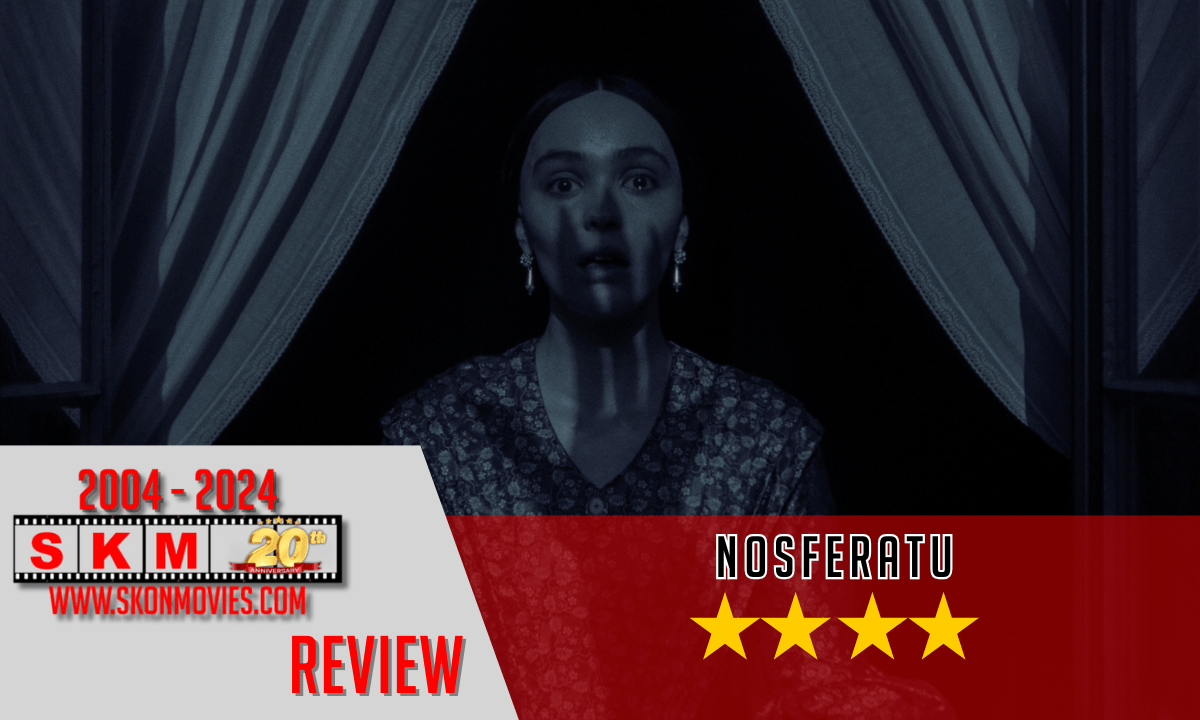Content Advisory: Death/harm to Child, Animal cruelty or animal death, Self-injurious behavior
Robert Eggers reimagines F.W. Murnau’s German Expressionist adaptation of Dracula with Nosferatu. In 1838 in the German city of Wisborg, real estate agent Thomas Hutter (Nicholas Hoult) is assigned by his employer Herr Knock (Simon McBurney) to visit the castle of Count Orlok (Bill Skarsgård), who plans to retire to a mansion in the city. Thomas’ wife worries his new wife Ellen (Lily-Rose Depp), who has been plagued with nightmares since childhood.
Left in the care of Thomas’ friend Friedrich Harding (Aaron Taylor-Johnson) and his wife Anna (Emma Corrin), the nightmares begin to return for Ellen, while her husband is away. Dr. Wilhelm Sievers (Ralph Ineson) attempts to treat Ellen’s ailments with conventional medicine. When that does not work, Sievers calls upon his teacher, controversial occult scientist Prof. Albin Eberhart Von Franz (Willem Dafoe), who comes to discover that Ellen is under the psychic control of the undead vampyr, Nosferatu.

Nosferatu (2024) Synopsis
Nosferatu is a gothic horror film written for the screen and directed by Roger Eggers (The Witch, The Lighthouse, The Northman). The film satisfies Eggers longtime desire to director a reimagining of F. W. Murnau’s 1922 German Expressionist Film Nosferatu: A Symphony of Horror, which was the first, albeit unauthorized, film based on Bram Stoker’s Dracula. Nosferatu was remade once before by Werner Herzog in 1979 as Nosferatu the Vampyre, which restored the character names from the novel.
For his version of Nosferatu, Robert Eggers returns to names used in F.W. Murnau’s film, though the plot is refocused to make Ellen Hutter, played by Lily-Rose Depp (Wolf, The Idol), the central protagonist of the film. It is established in the film’s prologue that Ellen already had a psychic connection with Count Orlok, played by Bill Skarsgård (The Crow), with the events that play out in the film being Orlok’s attempt to reunite with Ellen. With the help of Prof. Albin Eberhart Von Franz, played by a very scenery-chewing Willem Dafoe, Ellen discovers that she must be the one who breaks the curse of Nosferatu.
My Thoughts on Nosferatu (2024)
Nosferatu is arguably the film that Roger Eggers has been building his decade-long filmmaking career up to, with him previously having co-directed a stage version of F. W. Murnau’s film while he was in high school. Eggers’ Nosferatu was originally set to star his longtime collaborator Anya Taylor-Joy, who made her debut in 2015’s The Witch, but she had to drop out and was replaced by Lily-Rose Depp. While the daughter of Johnny Depp, who made her debut a decade ago in Kevin Smith’s Tusk, hasn’t yet had many notable roles, though Nosferatu is sure to do for the career of Lily-Rose Depp what The Witch did for Anya Taylor-Joy.
While Robert Eggers’ Nosferatu features very few jump scares, he succeeds in creating an unsettling atmosphere that emphasizes the pure evil of “The Vampyr.” Indeed, for his interpretation of the story, Roger Eggers decides to combine vampire mythology with that of demonic possession, as Ellen frequently goes into a trance or has sudden changes in personality. The marketing for Nosferatu opted to depict Bill Skarsgård’s Count Orlok only as a silhouette. Part of the reasoning for this is that Robert Eggers has reimagined the character as essentially a living rotting corpse, who is quite repulsive to look at. However, there is also one notable addition made to the look of Count Orlok, which I am sure is going to be controversial to purists, who have a very specific idea in their head of what he is supposed to look like.
In some ways, Robert Eggers makes his version of Nosferatu emblematic of the “faith vs science” debate. Specifically, this comes from Aaron Taylor-Johnson’s Friedrich Harding, who becomes highly skeptical that anything supernatural is happening. As with the original, the arrival of Count Orlok in the city of Wisborg is accompanied by thousands of rats and, in a move that has reportedly angered PETA, the vampire’s victims are made to look like victims of the Bubonic plague. This also allows Nosferatu to provide some subtle commentary on the response to the COVID-19 pandemic.
Nosferatu is emblematic of Robert Eggers’ role in the creation of the term “elevated horror,” where genre film is combined with a certain artistic flare. Instead of being a pure horror film, Robert Eggers’ Nosferatu is best described as a tragic gothic romance. While the film may alienate purists wanting a straightforward vampire tale, Eggers succeeds greatly in making this story his own.

